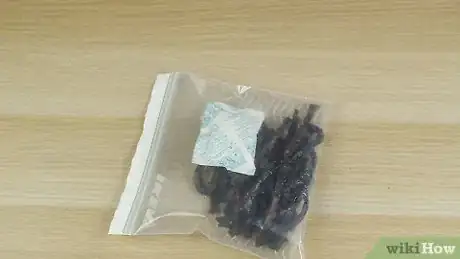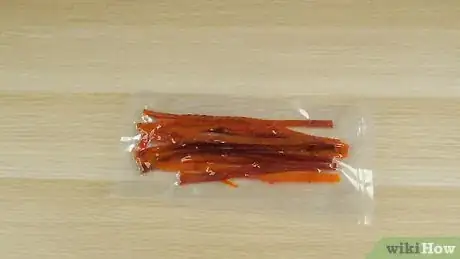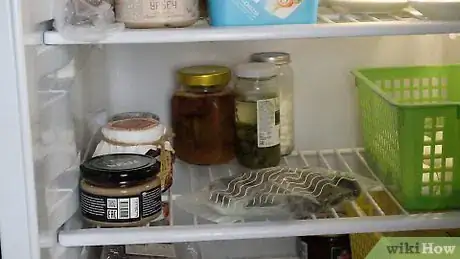This article was co-authored by wikiHow staff writer, Jessica Gibson. Jessica Gibson is a Writer and Editor who's been with wikiHow since 2014. After completing a year of art studies at the Emily Carr University in Vancouver, she graduated from Columbia College with a BA in History. Jessica also completed an MA in History from The University of Oregon in 2013.
The wikiHow Video Team also followed the article's instructions and verified that they work.
This article has been viewed 205,647 times.
Learn more...
You'd think that jerky should last forever, but it does have a shelf life. To help your jerky last as long as possible, remove all of the air from your storage bag or container. Label the bag and decide if you'll keep the jerky at room temperature, in the refrigerator, or in the freezer. Always check your jerky for signs of moisture or mold before you eat it.
Steps
Packaging the Jerky
-
1Dry the jerky at room temperature. If you've made your own jerky, let it cool for several hours so it's completely dry. If you see grease on the jerky, blot it with paper towels. Removing the moisture and fat helps the jerky last longer when you store it.[1]
- If you're storing store-bought jerky, you can skip directly to storing the jerky at room temperature or chilling it.
-
2Place the jerky in an airtight storage container. Put the jerky into an airtight storage bag or a glass container. Try to choose a container that's not much bigger than the amount of jerky you're storing. Too much oxygen will cause the jerky to spoil faster.[2]
- Glass storage containers are also great at keeping unwanted odors from flavoring your jerky.
Advertisement -
3Add oxygen absorbers to your bag or jar to extend the jerky’s shelf life. You can purchase food-grade oxygen absorbers from some grocery stores or online. Place 1 or 2 of them in each bag or container of jerky to extend the shelf life of the jerky. Then, press the air out of the bag and seal it or put the lid on your storage container.[3]
- The oxygen absorber will absorb the oxygen, which prevents bacteria from growing on the jerky.
-
4Vacuum seal the package for the most long-lasting jerky. Oxygen absorbers can remove a lot of oxygen from the bag, but a vacuum sealing machine removes almost all of it. Put the jerky into the bags that came with your machine and lock them into the machine. Turn it on so the machine sucks out all of the oxygen and shrinks the bag around the jerky.[4]
- Consider vacuum-sealing bags with different amounts of jerky so you can grab some bags for snacks and keep others for long-term storage.
Tip: If you plan on mailing jerky to someone, vacuum seal it first. This ensures that it will be in good condition when the person receives it.
-
5Label your container or bag of jerky. Write down what type of jerky is inside the container and write the date you packaged the jerky. Then, refer to the date on the package when you go to use the jerky.[5]
- If you make jerky throughout the year, remember to rotate the containers and use the oldest jerky before opening the newer jerky.
Storing the Jerky or Chilling It
-
1Leave the jerky at room temperature for up to 2 months. If you removed all of the moisture from the jerky when you made it, you should be able to safely store it in your pantry or cupboard for up to 2 months. If you see moisture in the bag after a few days, you'll need to dehydrate the jerky again so you can store it longer.[6]
- If you're storing storebought jerky at room temperature, it should last up to 1 year if you don't open the package.
Tip: Use your jerky within 1 week of opening, regardless of how you store it. Once you open the container, oxygen will enter it and can cause bacteria to grow.
-
2Store the jerky in the fridge for up to 2 weeks. Place your bag or container of jerky into the refrigerator if you're concerned that your pantry is hot and the jerky would spoil. Keep in mind that once you open the bag or container of jerky, you should eat it within 1 week since you've introduced oxygen into the bag or container.[7]
- If you don't like eating cold jerky, take it out of the fridge and set it on the counter for about 30 minutes so it comes to room temperature.
-
3Keep the jerky in the freezer for up to 6 months. For longer-term storage, put your bag or container of jerky into the freezer. Although this extends your storage time, it can change the flavor of the jerky. Consider freezing a small amount to see if you notice any changes before freezing a large batch of jerky.[8]
- To thaw the jerky, take it out of the freezer and place it in the fridge the night before you want to eat it. Place a paper towel in the bag to absorb moisture as the jerky thaws.
Community Q&A
-
QuestionTo use in a "prepping" situation, can jerky be frozen until needed, then kept for some time?
 Karl CuffCommunity AnswerAny type of food for "prepping" should be used within the suggested time frame (so one year for jerky would be stretching it, and any frozen jerky would need to be consumed quickly after dethawing due to increased moisture from freezing). That being said, in an actual survival scenerio, you would eat anything you could for caloric intake, even if the taste, texture, and safety of consumption were decreased.
Karl CuffCommunity AnswerAny type of food for "prepping" should be used within the suggested time frame (so one year for jerky would be stretching it, and any frozen jerky would need to be consumed quickly after dethawing due to increased moisture from freezing). That being said, in an actual survival scenerio, you would eat anything you could for caloric intake, even if the taste, texture, and safety of consumption were decreased. -
QuestionWhat is the best way to mail jerky?
 Community AnswerUse vac-sealing bags, then ship in a box.
Community AnswerUse vac-sealing bags, then ship in a box. -
QuestionMy jerky was delivered when I wasn't home, and it was in the mailbox for 2 days in 100 degree heat. Is it still safe to eat?
 Community AnswerAbsolutely not. You should return it.
Community AnswerAbsolutely not. You should return it.
Warnings
- Discard jerky that has an off odor or is covered with white. These are signs of mold, so you shouldn't eat the jerky.⧼thumbs_response⧽
Things You'll Need
- Sealable bags or airtight container
- Pen
- Oxygen absorbers, optional
- Paper towels, optional
- Vacuum sealing machine, optional
- Freezer or refrigerator, optional
References
- ↑ https://www.jerkyholic.com/how-long-does-beef-jerky-stay-good/
- ↑ https://www.fsis.usda.gov/wps/wcm/connect/fsis-content/internet/main/topics/food-safety-education/get-answers/food-safety-fact-sheets/meat-preparation/jerky-and-food-safety/ct_index
- ↑ https://youtu.be/I50FbHWmSy0?t=15
- ↑ https://youtu.be/QRJY8sTEWQw?t=209
- ↑ https://www.fsis.usda.gov/wps/wcm/connect/fsis-content/internet/main/topics/food-safety-education/get-answers/food-safety-fact-sheets/meat-preparation/jerky-and-food-safety/ct_index
- ↑ https://www.fsis.usda.gov/wps/wcm/connect/fsis-content/internet/main/topics/food-safety-education/get-answers/food-safety-fact-sheets/meat-preparation/jerky-and-food-safety/ct_index
- ↑ https://nchfp.uga.edu/how/dry/jerky.html
- ↑ https://nchfp.uga.edu/how/dry/jerky.html
About This Article
To store jerky, place it in an airtight container or bag and keep it at room temperature for up to 2 months. For longer storage, keep the jerky in the freezer, where it should last for up to 6 months. However you store your jerky, use it within a week once you open it. To improve the shelf life of your jerky, add a couple oxygen absorbers to the containter, or vacuum seal it. For more tips, including how to dry out your jerky, read on!

























































